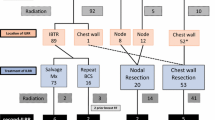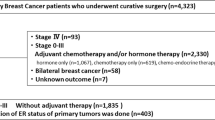Abstract
Purpose To determine the long-term overall survival of male patients with stage II node positive breast cancer treated with adjuvant chemotherapy.
Patients and methods Between 1974 and 1988, 31 male breast cancer patients were prospectively enrolled on study MB-82 in the National Cancer Institute. Following mastectomy, patients were treated with 12 cycles of cyclophosphamide, methotrexate, and fluorouracil (CMF) chemotherapy.
Results Median patient age was 61 years (38–74 years). Twenty-one patients (68%) had 1–3 positive axillary lymph nodes while ten patients (32%) had four or more positive nodes. Estrogen receptor status was positive in 22 (71%), negative in 1 (3%), and unknown in 8 (26%) tumors. Progesterone receptor status was positive in 18 (58%), negative in 3 (10%), and unknown in 10 (32%) tumors. Median potential follow-up for all patients is 22.5 years with a median survival of 16.3 years. Twenty-one of 31 patients have died; one from a treatment-related complication, nine patients from recurrent breast cancer, five from other cancers, one from non-cancer related causes, and five from unknown causes. Ten patients remain alive at a median of 19.2 years. The overall survival probability at 10 years is 64.5% (95% CI: 46.9–78.9%), at 15 years is 51.6% (95% CI: 34.8–68%), and at 20 years is 42.4% (95% CI: 25.8–60.8%).
Conclusion To our knowledge, 20-year prospective data with adjuvant chemotherapy in male breast cancer has never been reported. Adjuvant chemotherapy may benefit male breast cancer patients with positive nodes.

Similar content being viewed by others
References
Jemal A, Siegel R, Ward E et al (2006) Cancer statistics, 2006. CA Cancer J Clin 56(2):106–130
Giordano SH, Cohen DS, Buzdar AU et al (2004) Breast carcinoma in men: a population-based study. Cancer 101(1):51–57
Anderson WF, Devesa SS (2005) In situ male breast carcinoma in the Surveillance, Epidemiology, and End Results database of the National Cancer Institute. Cancer 104(8):1733–1741
Wainwright J (1927) Carcinoma of the male breast. Arch Surg 14:836–859
Heller KS, Rosen PP, Schottenfeld D et al (1978) Male breast cancer: a clinicopathologic study of 97 cases. Ann Surg 188(1):60–65
Ramantanis G, Besbeas S, Garas JG (1980) Breast cancer in the male: a report of 138 cases. World J Surg 4(5):621–623
Stierer M, Rosen H, Weitensfelder W et al (1995) Male breast cancer: Austrian experience. World J Surg 19(5):687–692; discussion 692–683
Donegan WL, Redlich PN, Lang PJ et al (1998) Carcinoma of the breast in males: a multiinstitutional survey. Cancer 83(3):498–509
Erlichman C, Murphy KC, Elhakim T (1984) Male breast cancer: a 13-year review of 89 patients. J Clin Oncol 2(8):903–909
Yap HY, Tashima CK, Blumenschein GR et al (1979) Male breast cancer: a natural history study. Cancer 44(2):748–754
Salvadori B, Saccozzi R, Manzari A et al (1994) Prognosis of breast cancer in males: an analysis of 170 cases. Eur J Cancer 30A(7):930–935
Cutuli B, Lacroze M, Dilhuydy JM et al (1995) Male breast cancer: results of the treatments and prognostic factors in 397 cases. Eur J Cancer 31A(12):1960–1964
Guinee VF, Olsson H, Moller T et al (1993) The prognosis of breast cancer in males. A report of 335 cases. Cancer 71(1):154–161
Goss PE, Reid C, Pintilie M et al (1999) Male breast carcinoma: a review of 229 patients who presented to the Princess Margaret Hospital during 40 years: 1955-1996. Cancer 85(3):629–639
Spence RA, MacKenzie G, Anderson JR et al (1985) Long-term survival following cancer of the male breast in Northern Ireland. A report of 81 cases. Cancer 55(3):648–652
Yildirim E, Berberoglu U (1998) Male breast cancer: a 22-year experience. Eur J Surg Oncol 24(6):548–552
Ribeiro GG (1977) Carcinoma of the male breast: a review of 200 cases. Br J Surg 64(6):381–383
Ribeiro G (1985) Male breast carcinoma—a review of 301 cases from the Christie Hospital & Holt Radium Institute, Manchester. Br J Cancer 51(1):115–119
Crichlow RW (1974) Breast cancer in men. Semin Oncol 1(2):145–152
Ribeiro G, Swindell R, Harris M et al (1996) A review of the management of the male breast carcinoma based on an analysis of 420 treated cases. Breast 5:141–146
Robison R, Montague ED (1982) Treatment results in males with breast cancer. Cancer 49(2):403–406
Appelqvist P, Salmo M (1982) Prognosis in carcinoma of the male breast. Acta Chir Scand 148(6):499–502
Crichlow RW (1972) Carcinoma of the male breast. Surg Gynecol Obstet 134(6):1011–1019
Bonadonna G, Brusamolino E, Valagussa P et al (1976) Combination chemotherapy as an adjuvant treatment in operable breast cancer. N Engl J Med 294(8):405–410
Bagley CS, Wesley MN, Young RC et al (1987) Adjuvant chemotherapy in males with cancer of the breast. Am J Clin Oncol 10(1):55–60
Beahrs OH, Myers M (eds) (1983) Manual for staging of cancer-american joint committee on cancer. J.B. Lippincott Co., Philadelphia
Kaplan E, Meier P (1958) Non-parametric estimation from incomplete observation. J Am Statist Assoc 53:457–481
Surveillance, Epidemiology, End results (SEER) Program (www.seer.cancer.gov) SEER STAT database: Incidence- SEER 17 Regs Public-use; November 2005 submission for survival analyses [1973–2003 varying], National Cancer Institute, DCCPS, Surveillance Research Program, Cancer Statistics Branch, released April 2006
Patel HZ II, Buzdar AU, Hortobagyi GN (1989) Role of adjuvant chemotherapy in male breast cancer. Cancer 64(8):1583–1585
Izquierdo MA, Alonso C, De Andres L et al (1994) Male breast cancer. Report of a series of 50 cases. Acta Oncol 33(7):767–771
Giordano SH, Perkins GH, Broglio K et al (2005) Adjuvant systemic therapy for male breast carcinoma. Cancer 104(11):2359–2364
Rosenblatt KA, Thomas DB, McTiernan A et al (1991) Breast cancer in men: aspects of familial aggregation. J Natl Cancer Inst 83(12):849–854
D’Avanzo B, La Vecchia C (1995) Risk factors for male breast cancer. Br J Cancer 71(6):1359–1362
Sasco AJ, Lowenfels AB, Pasker-de Jong P (1993) Review article: epidemiology of male breast cancer. A meta-analysis of published case-control studies and discussion of selected aetiological factors. Int J Cancer 53(4):538–549
Schottenfeld D, Lilienfeld AM, Diamond H (1963) Some observations on the epidemiology of breast cancer among males. Am J Public Health 53:890–897
Storm HH, Olsen J (1999) Risk of breast cancer in offspring of male breast-cancer patients. Lancet 353(9148):209
Hemminki K, Vaittinen P (1999) Male breast cancer: risk to daughters. Lancet 353(9159):1186–1187
Travis LB, Hill DA, Dores GM et al (2003) Breast cancer following radiotherapy and chemotherapy among young women with Hodgkin disease. JAMA 290(4):465–475
Auvinen A, Curtis RE, Ron E (2002) Risk of subsequent cancer following breast cancer in men. J Natl Cancer Inst 94(17):1330–1332
Struewing JP, Brody LC, Erdos MR et al (1995) Detection of eight BRCA1 mutations in 10 breast/ovarian cancer families, including 1 family with male breast cancer. Am J Hum Genet 57(1):1–7
Ford D, Easton DF, Stratton M et al (1998) Genetic heterogeneity and penetrance analysis of the BRCA1 and BRCA2 genes in breast cancer families. The Breast Cancer Linkage Consortium. Am J Hum Genet 62(3):676–689
Osorio A, Barroso A, Martinez B et al (2000) Molecular analysis of the BRCA1 and BRCA2 genes in 32 breast and/or ovarian cancer Spanish families. Br J Cancer 82(7):1266–1270
Sasano H, Kimura M, Shizawa S et al (1996) Aromatase and steroid receptors in gynecomastia and male breast carcinoma: an immunohistochemical study. J Clin Endocrinol Metab 81(8):3063–3067
Anderson WF, Althuis MD, Brinton LA et al (2004) Is male breast cancer similar or different than female breast cancer? Breast Cancer Res Treat 83(1):77–86
Ribeiro G, Swindell R (1992) Adjuvant tamoxifen for male breast cancer (MBC). Br J Cancer 65(2):252–254
Nahleh ZA (2006) Hormonal therapy for male breast cancer: a different approach for a different disease. Cancer Treat Rev 32(2):101–105
Munoz de Toro MM, Maffini MV, Kass L et al (1998) Proliferative activity and steroid hormone receptor status in male breast carcinoma. J Steroid Biochem Mol Biol 67(4):333–339
Weber-Chappuis K, Bieri-Burger S, Hurlimann J (1996) Comparison of prognostic markers detected by immunohistochemistry in male and female breast carcinomas. Eur J Cancer 32A(10):1686–1692
http://www.swog.org/Visitors/ViewProtocolDetails.asp?ProtocolID=1995
Acknowledgments
This research was supported by the Intramural Research Program of the NIH, National Cancer Institute, Center for Cancer Research.
Author information
Authors and Affiliations
Corresponding author
Additional information
The U.S. Government's right to retain a non-exclusive, royalty-free license in and to any copyright is acknowledged.
Rights and permissions
About this article
Cite this article
Walshe, J.M., Berman, A.W., Vatas, U. et al. A prospective study of adjuvant CMF in males with node positive breast cancer: 20-year follow-up. Breast Cancer Res Treat 103, 177–183 (2007). https://doi.org/10.1007/s10549-006-9363-0
Received:
Accepted:
Published:
Issue Date:
DOI: https://doi.org/10.1007/s10549-006-9363-0




